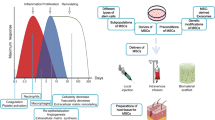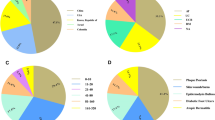Abstract
Researches on stem cells bring promise to functional skin repair. In particular, it has been recently suggested that mesenchymal stem cells (MSCs) could positively affect cutaneous wound healing through differentiation and paracrine action. The molecular mechanisms are not clear, even if there is increasing evidence for an important action of nitric oxide (NO), probably mediated by the regulation of the gene encoding for vascular endothelial growth factor (VEGF). The aim of our study was to investigate the immunohistochemical expression of VEGF and nitric oxide synthase (NOS) isoforms in human skin-derived MSCs, as well as the production of VEGF and NO, because these cells are less well characterized than bone marrow MSCs. MSCs were obtained from skin biopsies of healthy adult patients undergoing cosmetic plastic surgery, expanded and characterized for specific surface antigens. The cells were then evaluated for the immunohistochemical expression of VEGF, and NOS isoforms, as well as for VEGF and NO secretion in cell culture medium. Our immunohistochemical analysis showed that proliferating MSCs derived from human skin exhibit VEGF expression at cytoplasmic level as well as cytosolic and nuclear localization of all the three isoforms of NOS, even if with different patterns. In addition, our data evidenced the release of both VEGF and NO in cell culture supernatants. In conclusion, our results suggest that a therapeutic approach based on the human skin-derived MSCs may have a positive effect in wound healing conditions, through their ability to provide VEGF and NO to the damaged area.






Similar content being viewed by others
References
Badiavas EV, Falanga V (2003) Treatment of chronic wounds with bone marrow-derived cells. Arch Dermatol 139:510–516
Bredt DS, Snyder SH (1994) Nitric oxide: a physiologic messenger molecule. Annu Rev Biochem 63:175–195
Caplan AI, Dennis JE (2006) Mesenchymal stem cells as trophic mediators. J Cell Biochem 98:1076–1084
Cobbold CA (2001) The role of nitric oxide in the formation of keloid and hypertrophic lesions. Med Hypotheses 57:497–502
Estrada R, Li N, Sarojini H, An J, Lee M-J, Wang E (2009) Secretome from mesenchymal stem cells induces angiogenesis via Cyr61. J Cell Physiol 219:563–571
Falanga V (2005) Wound healing and its impairment in the diabetic foot. Lancet 366:1736–1743
François S, Mouseddine M, Mathieu N, Semont A, Monti P, Dudoignon N, Saché A, Boutarfa A, Thierry D, Gourmelon P, Chapel A (2007) Human mesenchymal stem cells favour healing of the cutaneous radiation syndrome in a xenogenic transplant model. Ann Hematol 86:1–8
Frank S, Stallmeyer B, Kämpfer H, Kolb N, Pfeilschifter J (1999) Nitric oxide triggers enhanced induction of vascular endothelial growth factor expression in cultured keratinocytes (HaCaT) and during cutaneous wound repair. FASEB J 13:2002–2014
Frank S, Kämpfer H, Wetzler C, Pfeilschifter J (2002) Nitric oxide drives skin repair: novel functions of an established mediator. Kidney Int 61:882–888
Giordano A, Tonello C, Bulbarelli A, Cozzi V, Cinti S, Carruba MO, Nisoli E (2002) Evidence for a functional nitric oxide synthase system in brown adipocyte nucleus. FEBS Lett 514:135–140
Herrera MB, Bruno S, Buttiglieri S, Tetta C, Gatti S, Deregibus MC, Bussolati B, Camussi G (2006) Isolation and characterization of a stem cell population from adult human liver. Stem Cells 24:2840–2850
In’t Anker PS, Scherjon SA, Kleijburg-van der Keur C, de Groot-Swings GM, Claas FH, Fibbe WE, Kanhai HH (2003) Amniotic fluid as a novel source of mesenchymal stem cells for therapeutic transplantation. Blood 102:1548–1549
Ishida H, Ray R, Ray P (2008) Sulfur mustard downregulates iNOS expression to inhibit wound healing in a human keratinocyte model. J Dermatol Sci 49:207–216
Kinnaird T, Stabile E, Burnett MS, Shou M, Lee CW, Barr S, Fuchs S, Epstein SE (2004) Local delivery of marrow-derived stromal cells augments collateral perfusion through paracrine mechanisms. Circulation 109:1543–1549
Klinz FJ, Schmidt A, Schinköthe T, Arnhold S, Desai B, Popken F, Brixius K, Schwinger R, Mehlhorn U, Staib P, Addicks K, Bloch W (2005) Phospho-eNOS Ser-114 in human mesenchymal stem cells: constitutive phosphorylation, nuclear localization and upregulation during mitosis. Eur J Cell Biol 84:809–818
Lee PC, Salyapongse AN, Bragdon GA, Shears LL II, Watkins SC, Edington HD, Billiar TR (1999) Impaired wound healing and angiogenesis in eNOS-deficient mice. Am J Physiol 277:H1600–H1608
Li H, Fu X, Ouyang Y, Cai C, Wang J, Sun T (2006) Adult bone-marrow-derived mesenchymal stem cells contribute to wound healing of skin appendages. Cell Tissue Res 326:725–736
McNaughton L, Puttagunta L, Martinez-Cuesta MA, Kneteman N, Mayers I, Moqbel R, Hamid Q, Radomski MW (2002) Distribution of nitric oxide synthase in normal and cirrotic human liver. Proc Natl Acad Sci USA 99:17161–17166
Minardi D, Lucarini G, Filosa A, Milanese G, Zizzi A, Di Primio R, Montironi R, Muzzonigro G (2008) Prognostic role of tumor necrosis, microvessel density, vascular endothelial growth factor and hypoxia inducible factor-1alpha in patients with clear cell renal carcinoma after radical nephrectomy in a long term follow-up. Int J Immunopathol Pharmacol 21:447–455
Moncada S (1999) Nitric oxide: discovery and impact on clinical medicine. J R Soc Med 92:164–169
Nissen NN, Polverini PJ, Koch AE, Volin MV, Gamelli RL, Di Pietro LA (1998) Vascular endothelial growth factor mediates angiogenic activity during the proliferative phase of wound healing. Am J Pathol 152:1445–1452
Orciani M, Emanuelli M, Martino C, Pugnaloni A, Tranquilli AL, Di Primio R (2008) Potential role of culture mediums for successful isolation and neuronal differentiation of amniotic fluid stem cells. Int J Immunopathol Pharmacol 21:595–602
Ozawa K, Sato K, Oh I, Ozaki K, Uchibori R, Obara Y, Kikuchi Y, Ito T, Okada T, Urabe M, Mizukami H, Kume A (2008) Cell and gene therapy using mesenchymal stem cells (MSCs). J Autoimmun 30:121–127
Pittenger MF, Mackay AM, Beck SC, Jaiswal RK, Douglas R, Mosca JD, Moorman MA, Simonetti DW, Craig S, Marshak DR (1999) Multilineage potential of adult human mesenchymal stem cells. Science 284:143–147
Rasulov MF, Vasilchenkov AV, Onishchenko NA, Krasheninnikov ME, Kravchenko VI, Gorshenin TL, Pidtsan RE, Potapov IV (2005) First experience of the use bone marrow mesenchymal stem cells for the treatment of a patient with deep skin burns. Bull Exp Biol Med 139:141–144
Ringden O, Uzunel M, Rasmusson I, Remberger M, Sundberg B, Lönnies H, Marschall HU, Dlugosz A, Szakos A, Hassan Z, Omazic B, Aschan J, Barkholt L, Le Blanc K (2006) Mesenchymal stem cells for treatment of therapy-resistant graft-versus-host-disease. Transplantation 81:1390–1397
Sato K, Ozaki K, Oh I, Meguro A, Hatanaka K, Nagai T, Muroi K, Ozawa K (2007) Nitric oxide plays a critical role in suppression of T cell proliferation by mesenchymal stem cells. Blood 109:228–234
Stallmeyer B, Kämpfer H, Kolb N, Pfeilschifter J, Frank S (1999) The function of nitric oxide in wound repair: inhibition of inducible nitric oxide-synthase severely impairs wound reepithelization. J Invest Dermatol 113:1090–1098
Sun Y, Jin K, Xie L, Childs J, Mao XO, Logvinova A, Greenberg DA (2003) VEGF-induced neuroprotection, neurogenesis, and angiogenesis after focal cerebral ischemia. J Clin Invest 111:1843–1851
Sze SK, de Kleijn DP, Lai RC, Khia Way Tan E, Zhao H, Yeo KS, Low TY, Lian Q, Lee CN, Mitchell W, El Oakley RM, Lim SK (2007) Elucidating the secretion proteome of human embryonic stem cell-derived mesenchymal stem cells. Mol Cell Proteomics 6:1680–1689
Wang D, Braendstrup O, Larsen S, Horn T, Strandgaard S (2004) The expression and activity of renal nitric oxide synthase and circulating nitric oxide in polycystic kidney disease rats. APMIS 112:358–368
Witte MB, Thornton FJ, Efron DT, Barbul A (2000) Enhancement of fibroblast collagen synthesis by nitric oxide. Nitric Oxide 4:572–582
Wu Y, Chen L, Scott PG, Tredget EE (2007) Mesenchymal stem cells enhance wound healing through differentiation and angiogenesis. Stem Cells 25:2648–2659
Yuan Z, Liu B, Yuan L, Zhang Y, Dong X, Lu J (2004) Evidence of nuclear localization of neuronal nitric oxide synthase in cultured astrocytes of rats. Life Sci 74:3199–3209
Ziche M, Morbidelli L (2000) Nitric oxide and angiogenesis. J Neurooncol 50:139–148
Zuk PA, Zhu M, De Ashjian P, Ugarte DA, Huang JI, Mizuno H, Alfonso ZC, Fraser JK, Benhaim P, Hedrick MH (2002) Human adipose tissue is a source of multipotent stem cells. Mol Biol Cell 13:4279–4295
Zvaifler NJ, Marinova-Mutafchieva L, Adams G, Edwards CJ, Moss J, Burger JA, Maini RN (2000) Mesenchymal precursor cells in the blood of normal individuals. Arthritis Res 2:477–488
Acknowledgments
This work was supported by RSA Grants from Polytechnic University of Marche, Ancona, Italy.
Conflict of interest statement
The authors state no conflict of interest.
Author information
Authors and Affiliations
Corresponding author
Rights and permissions
About this article
Cite this article
Salvolini, E., Lucarini, G., Zizzi, A. et al. Human skin-derived mesenchymal stem cells as a source of VEGF and nitric oxide. Arch Dermatol Res 302, 367–374 (2010). https://doi.org/10.1007/s00403-009-1018-7
Received:
Revised:
Accepted:
Published:
Issue Date:
DOI: https://doi.org/10.1007/s00403-009-1018-7




